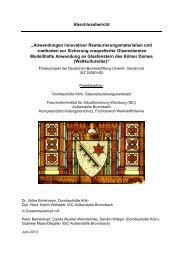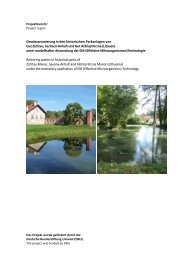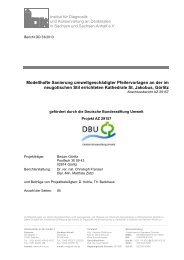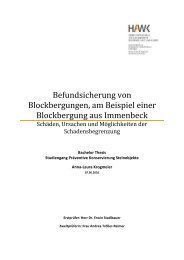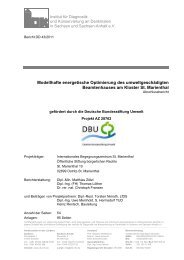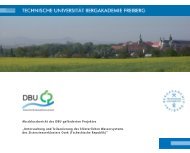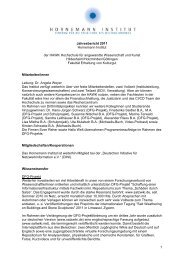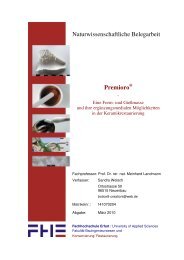Download PDF
Download PDF
Download PDF
Sie wollen auch ein ePaper? Erhöhen Sie die Reichweite Ihrer Titel.
YUMPU macht aus Druck-PDFs automatisch weboptimierte ePaper, die Google liebt.
Weichmacherverlust bei PVC-Objekten von Joseph Beuys – Versuche zu kurativen und konservatorischen Massnahmen<br />
ANHANG III: ZUSAMMENSTELLUNG VON ABSTRACTS<br />
Rodríguez-Fernández, O. S.; Gilbert, M. (1997): Aminosilane grafting of plasticized poly(vinyl chloride) I.<br />
Extent and rate of crosslinking. In: Journal of Applied Polymer Science, Vol. 66, Issue 11, S. 2111-2119<br />
The grafting of poly(vinyl chloride) (PVC) by reactive aminosilane compounds, which make them moisture-curable, has<br />
been investigated. Plasticized poly-(vinyl chloride) has been successfully grafted with aminosilane during extrusion. The<br />
grafted polymer was crosslinked in the presence of moisture. Although the hydrolysis and condensation of the<br />
crosslinking agent is very rapid, the speed of the reaction is controlled by the rather slow diffusion of water in the<br />
plasticized PVC. This water diffusion speed follows Fick's Law and is strongly dependent on temperature. To achieve<br />
a high crosslinking speed, the extruded PVC has to be placed in warm water or in a steam heated vessel. The effects<br />
of catalyst concentration, moisture concentration, and immersion time and temperature on the rate and degree of<br />
crosslinking were investigated. Since the formulation used contained a tin stabilizer, the addition of a tin catalyst to<br />
the immersion water had little effect. Crosslinking did occur in samples stored at room temperature due to the<br />
presence of moisture, but the reaction rate was increased substantially if the sample was immersed in water.<br />
Reaction rate was very temperature dependent and followed an Arrhenius relationship.<br />
Ikada, Y. (1994): Surface modification of polymers for medical applications. In: Biomaterials, Vo. 15, Issue<br />
10, S. 725-736<br />
(...) This review article focuses on the surface modification of polymers by grafting techniques, which have long been<br />
known in polymer chemistry but are not yet widely applied to biomaterials. A grafted surface can be produced<br />
primarily either by graft polymerization of monomers or covalent coupling reaction of existing polymer molecules onto<br />
the substrate polymer surface. The major surface properties that should be modified include two kinds of<br />
biocompatibility. One is the surface property that elicits the least foreign-body reactions and the other is the cell- and<br />
tissuebonding capability. In addition, physiologically active surfaces with, for instance, selective adsorbability may be<br />
required. Attempts to produce these biocompatible or biospecific surfaces by grafting techniques are briefly<br />
overviewed in this article.<br />
Krishnan, V. Kalliyana; Jayakrishnan A.; Francis, Joseph D. (1991): Radiation grafting of hydrophilic monomers on to<br />
plasticized poly (vinyl chloride) sheets : II. Migration behaviour of the plasticizer from N-vinyl pyrrolidone grafted<br />
sheets. In: Biomaterials, Volume 12, Issue 5 , July 1991, S. 489-492<br />
The grafting of N-vinyl pyrrolidone, a hydrophilic monomer, on to flexible poly(vinyl chloride) sheets used in medical<br />
applications using ionizing radiation from a 60Co source was studied. The graft yield was found to increase linearly<br />
with monomer concentration and also with increasing radiation doses. The migration of the plasticizer di-(2-<br />
ethylhexyl)phthalate into a strong organic extractant such as n-hexane was studied at different time intervals for<br />
different grafted systems of poly(viny) chloride) at 30°C. The results indicated a drastic reduction in the leaching of the<br />
plasticizer from grafted systems versus ungrafted controls. Incorporation of ethylene dimethacrylate cross-linker<br />
during grafting did not seem to affect the graft yield considerably but appeared to further reduce the plasticizer<br />
migration. Surface energy calculations of the grafted samples indicate that the surfaces are highly hydrophilic<br />
compared to ungrafted poly(viny) chloride) and the polar and dispersion components tend to vary with increasing<br />
cross-linker concentration.




